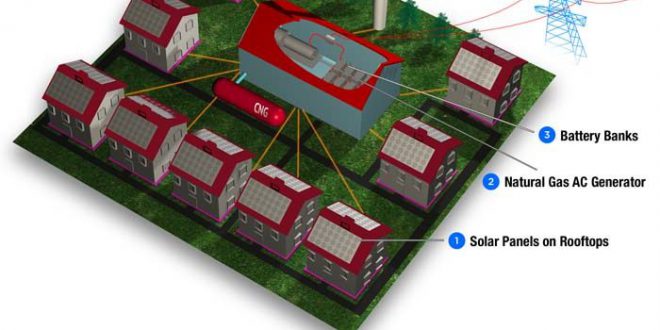Utility microgrids can yield numerous benefits to customers and communities. especially as prosumers bring new technologies and sources of power to the grid and customers demand greater electric reliability.
Those benefits include resilience. improved integration of distributed energy resources (DER). cost savings and environmental pluses. That was the message from participants in a Microgrid 2019 conference panel. Providing Public Benefits for Consumers. Business &. Communities with Utility Microgrids.
Said Allan Schurr. chief commercial officer. Enchanted Rock. which designs. builds and operates natural gas-based microgrids. The most logical extension of a utility is delivering reliable power. let’s not let the meter get in the way.
Jason Handley. Duke Energy’s director of smart grid technology and operations. launched the discussion with an overview of the factors altering the grid that provide opportunities for microgrids.
Millennials like to adopt new technologies. he noted.
When new technologies become available. they like to make it their own. he said. These new options include behind-the-meter technologies that are affecting supply and demand and sparking a need for more storage. solar and demand response. In addition. Duke. like many utilities. aims to bring more renewable energy to the grid. The utility wants to grow its 6.400 MW of renewables to 8.000 MW by 2020. he said.
Meanwhile. the adoption of electric vehicles (EV) has created capacity challenges and a need for new infrastructure.
Duke Energy’s utility microgrids
Duke has a number of microgrid projects installed and underway that aim to address these and other issues.
For example. the Mt. Sterling solar-plus-storage remote microgrid provides power to a communications tower located on National Park Service property in the Great Smoky Mountains on Mt. Sterling. Haywood County. North Carolina. It replaced a 12.47–kV grid-connected distribution feeder. operating independently of the grid.
Handley says that the falling cost of solar and lithium ion batteries makes such non-wires alternatives “pencil out.“
Another Duke microgrid provides resiliency at a fire station. the McAlpine microgrid test site in Charlotte. NC. That’s a fire station connected to a substation with a 50-kW solar array and 500-kW lithium-ion battery.
And a solar-plus-storage microgrid at the University of South Florida. St. Petersburg. helps address capacity issues associated with two direct current fast chargers for electric vehicles. “That helps smooth that loading.“ he said. It includes a 100-kW solar array and a Tesla battery system.
The North Carolina Utilities Commission recently approved a Duke microgrid in Hot Springs. N.C. that will help improve electric reliability. provide services to the overall electric system and serve as a backup power supply to the town.
We want to have a diverse offering. said Handley. We want to be able to provide whatever function is needed for customers — regulated and non regulated — as energy-as-service.
Microgrids and DERMS in Australia
In the second presentation. David Jeon. technical services manager. Pxise Energy Solutions. focused on how microgrids can serve as a foundation for distributed energy resource management systems (DERMS). solving challenges that DERMs can’t solve alone.
In Australia. Pxise found that DERMS didn’t solve all the issues related to integrating distributed energy into a projec for Horizon Power.
In addition. an avocado farmer in San Diego wrought havoc on the grid by bringing on 1 MW of solar at the end of a long distribution line. he said.
DERMS is partially the answer. Jeon said. We need new tools to adopt to distributed power. With intermittent resources. the grid frequency becomes less stable.
While DERMs can provide information about the optimal amounts of distributed energy that can be added to the grid. they don’t provide real-time adjustments. he said.
Microgrids can help solve these challenges.
From our experience. local microgrids are needed to control assets and smooth out the system in real time. he said.
While DERMS can provide optimization and scheduling. microgrids can control the grid at the distribution level. They can take control of distribution and stabilize it as more DERs come in. he said. Then you have all these microgrids working together to direct power flow. As more load is introduced. you can manage the grid down to the distribution level.
3 ways to work with utilities
In a third presentation focusing on the need to collaborate with utilities — rather than compete with them — Schurr described the advantages of using natural-gas fired generators. rather than diesel. in microgrids.
Diesel generators are expensive to maintain and don’t always run when they’re needed. Many diesel generators didn’t do their job during Superstorm Sandy. he noted.
Microgrid companies have three ways to work with utilities. he said: Utility enabled. utility owned. and utility optimized.
Under the utility enabled. behind-the-meter model. a third party is the builder. owner and operator. and the customer gets the reliability and power.
Under the utility-owned model. the utility owns the microgrid and can provide it as a regulated service. The utility provides the interconnection. but the asset is located behind the meter. This is a resource that in aggregate can have a meaningful impact at the grid or utility level. he said.
This can be behind the meter or can be front of meter. but for the sole purpose of customer resiliency. he explained. Duke Florida is one of a handful of utilities that has a tariff to build and operate behind-the-meter resiliency microgrids and collect a monthly fee from the customers.
Under the third. or utility optimized model. the utility owns either a behind-the-meter or front-of-meter system. and the system provides both customer resiliency plus non-wires alternatives or fast-start peaking for grid stability.
Providing these services and delivering reliable power can be a new revenue stream for utilities. Schurr said.
No one wants to have power outages. he said. Utility microgrids can have a powerful impact. a re-architecting of the way the grid is built.
 Iran Energy News Oil, Gas, Petrochemical and Energy Field Specialized Channel
Iran Energy News Oil, Gas, Petrochemical and Energy Field Specialized Channel




